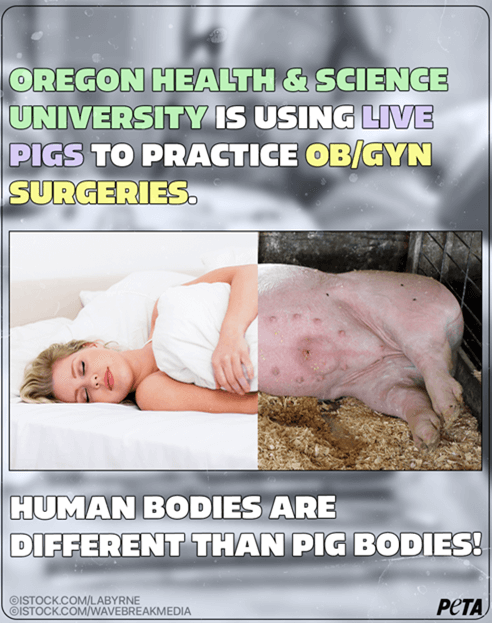Did Your Gynecologist Train on Pig or Human Anatomy?
If you’re looking for a career in pig gynecology, Oregon Health & Science University (OHSU) should be your first choice for training. But if you intend to be a gynecologist for humans, you may want to look elsewhere.
That’s because doctors-in-training in OHSU’s obstetrics and gynecology (OB/GYN) residency program use live pigs as human stand-ins to practice surgeries—a cruel and unnecessary anachronism akin to using Morse code in an era of text messaging—which fails to prepare them to provide care for humans. Following the practice surgeries, the pigs are killed.
OB/GYN programs such as those at Rush University or Aurora Sinai Medical Center are more befitting a budding doctor of human obstetrics and gynecology. Those programs, along with the majority of accredited universities recognized by the Accreditation Council for Graduate Medical Education, use advanced, human-relevant simulators instead of killing pigs.

Why?
For starters, familiarity with human anatomy is crucial, because lifesaving medical decisions must often be made in seconds, and pigs and other animals can’t accurately mimic human anatomy.
Pigs Aren’t Humans
Pig uteruses have an entirely different structure than those of humans, and there are myriad microscopic anatomical differences between pigs and humans when it comes to all the other organs, too. Learn on a pig and you’ll become good at helping pigs. Learn on a structure that mimics human anatomy and you’ll become good at helping humans. It’s not difficult to understand why training on one doesn’t teach you anything about the other.
Actual Military Intelligence
Even the U.S. Department of Defense has banned the use of animals for OB/GYN residency training and several other medical education areas since 2015.
Better, Cheaper, and in Use
Obstetrics and gynecology simulators ranging from partial-task trainers to full human-patient simulators and advanced virtual reality systems, such as those used at Rush University, are available. For instance, researchers have validated a cost-effective non-animal simulation model to teach vaginal hysterectomy, and another study found that high-fidelity simulators were “cheaper than practicing on laboratory animals” in the long term.
Substandard Education
What this all adds up to is inferior training that puts future doctors and their patients at a serious disadvantage. Wouldn’t it make more sense for medical students who will have human patients to train on humans or an effective replica? You don’t need a medical degree to figure that out.
What You Can Do
Please take a minute to tell OHSU to abandon its cruel, deadly training on live pigs and adopt a public policy banning the use of live animals in its OB/GYN residency training program.

